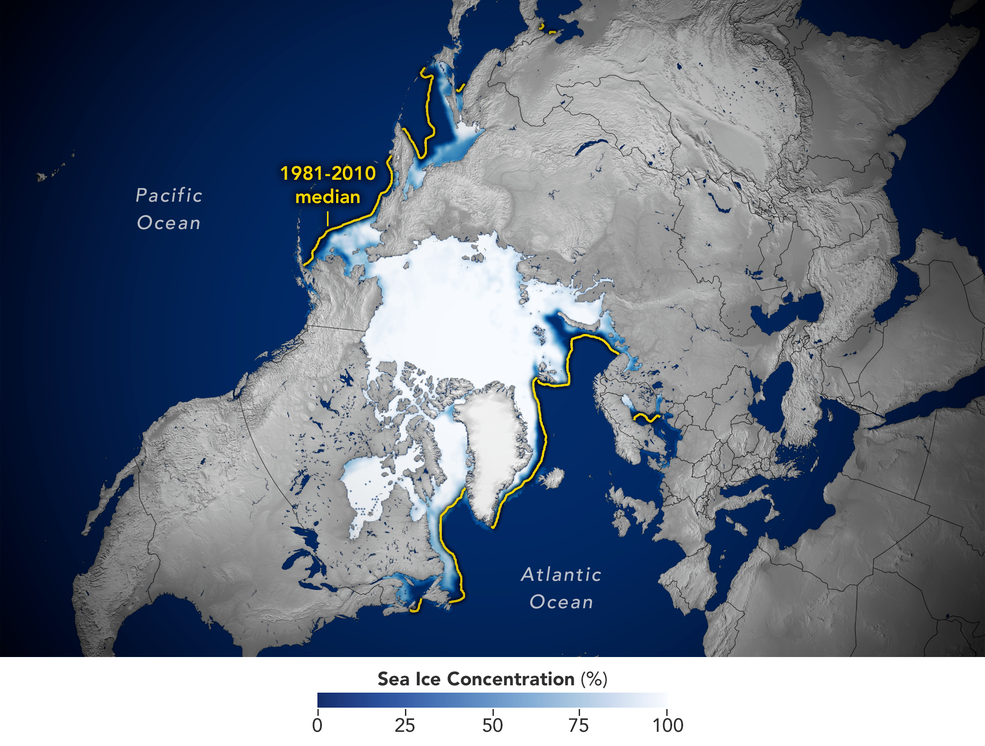After growing through fall and winter, arctic sea ice appears to have hit its yearly maximum extent on February 25th, 2022. This wintertime extent of the year is the 10th-lowest in the satellite record retained by the National Snow and Ice Data Center, one of NASA’s Distributed Active Archive Centers.
 This image shows the average concentration of Arctic sea ice on February 25th, 2022. The yellow outline shows the median sea ice extent for the month of March, when the ice generally reaches its maximum extent, as observed by satellites from 1981 to 2010. A median is the middle value. That is, half of the extents were larger than the line, and half were smaller. Image Credit: Joshua Stevens/NASA Earth Observatory
This image shows the average concentration of Arctic sea ice on February 25th, 2022. The yellow outline shows the median sea ice extent for the month of March, when the ice generally reaches its maximum extent, as observed by satellites from 1981 to 2010. A median is the middle value. That is, half of the extents were larger than the line, and half were smaller. Image Credit: Joshua Stevens/NASA Earth Observatory
Arctic sea ice extent went high at 5.75 million square miles (14.88 million square kilometers) and is approximately 297,300 square miles (770,000 square kilometers) below 1981 to 2010 average maximum. It is equivalent to missing an area of ice that is slightly bigger compared to Texas and Maine combined. This maximum ties with 2015 as the third earliest on record.
On a yearly basis, sea ice waxes and wanes with the seasons. In the Arctic, it achieves its maximum extent around March following growing through the colder months and decreases to its minimum extent in September after melting in the warmer months. In the Southern Hemisphere, an opposite cycle has been followed by the Antarctic sea ice.
To evaluate the sea ice extent, satellite sensors collect sea ice data that has been processed into daily images. Here, each image grid cell spans an area of approximately 15 miles by 15 miles (25 km by 25 km). Furthermore, scientists make use of these images to evaluate the extent of the ocean where sea ice spans a minimum of 15% of the water.
As satellites started reliably tracking sea ice in 1979, optimum extents in the Arctic have dropped at a speed of around 13% every 10 years. This has the minimum extents falling at nearly 2.7% per decade.
These trends are connected to warming caused as a result of human activities like emitting carbon dioxide. This traps heat in the air and causes an increase in temperatures. Also, NASA’s analysis shows how the Arctic is warming nearly three times quicker compared to other regions.
This February (2022), Antarctic sea ice declined to a record-low minimum extent. However, unlike in the Arctic, this sea ice has displayed uneven ups and downs mostly due to the geographical features that encircle it. Winds and ocean currents associated with the Southern Ocean and Antarctica have a powerful impact on the sea ice extent.
In the Arctic, sea ice has been encircled by land, whereas sea ice in the Antarctic is surrounded just by the ocean and can thus spread out more freely. On the whole, the Antarctic sea ice record displays a slightly upward–but almost flat–trend or increase.
Benefits in the Antarctic sea ice are not large enough to offset the Arctic losses. The ice present in both regions helps control global temperatures. Also, if the Antarctic gains balanced sea ice levels throughout the world, Arctic sea ice losses could still add up to additional regional and global warming.